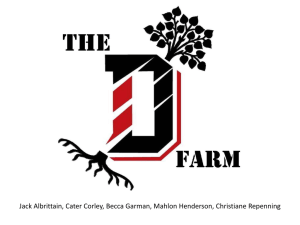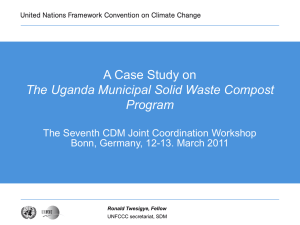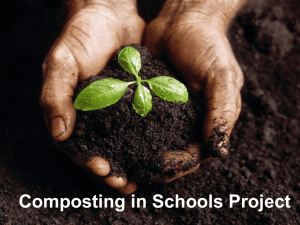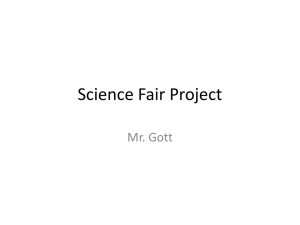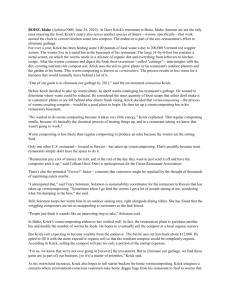View original Presentation Deck
advertisement
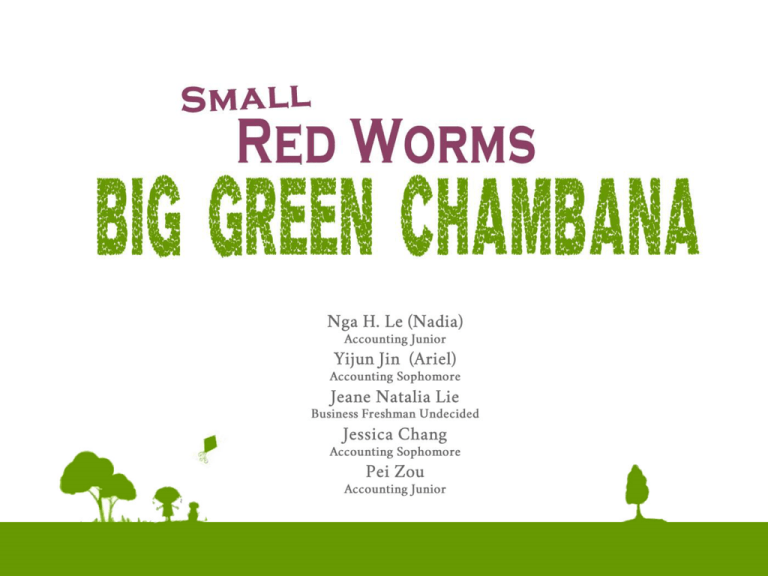
The Food Waste Problem… Champaign-Urbana National Situation The US generates approximately 34 million tons of food waste annually. Food waste accounts for up to 14% of landfill contents, and is the largest component of municipal solid waste. Methane, a greenhouse gas emitted from rotten food waste, is 21 times more harmful than CO2 when it comes to Global Warming. Majority of the US population fails to understand the benefits of recycling. Residential and commercial sectors in the Champaign/Urbana area, generate approximately 12 – 13 thousand tons of food waste per year. University Dining halls in Champaign/Urbana throw away an average of 65 bags of food waste (or 10,896 pounds of food) per year. A single student produces an average of 1,280 pounds of food waste per academic year. In 2010, only 3% of food waste was recycled, leaving 97 % (33 million tons) that was sent to the landfills, thus polluting the environment. http://www.epa.gov/osw/conserve/materials/organics/food/fd-basic.htm http://infohouse.p2ric.org/ref/06/05483.pdf http://www.dailyillini.com/index.php/article/2010/02/going_trayless_reduces_f ood_waste_in_dining_halls 2 We aim to inspire people to build a greener living community. We plan to create an environmentally sustainable initiative by establishing a food waste recycling system, a system that effectively and efficiently utilizes limited resources. We intend to achieve our mission by starting a composting project that addresses environmental, educational, and entrepreneurial aspects. 3 Our Solution Short-term Goal: Long-term Goal: Recycle food waste collected from three agricultural fraternities by means of vermicomposting. Utilize the compost fertilizer on the Sustainable Student Farm. Set up a food waste recycling system in Champaign/Urbana in order to limit the quantity of wasted resources and to build a sustainable community. Who’s Involved? Short-term: Agricultural fraternities: Alpha Gamma Rho, Naborhouse and Farmhouse. Us! We have taken steps to involve University & Community volunteers in aiding our initiative. Long-term: The Greek System: The University of Illinois has the largest Greek system nationwide with 6,850 members in 59 Fraternities and 36 sororities. Each sorority or fraternity has its own house and chef. University dining halls: There are 7 major dining halls serving 8,550 students per day. Champaign-Urbana community: including restaurants, high schools and households in ChampaignUrbana. Where? Sustainable Student Farm: Sustainable Student Farm is funded by the University of Illinois. It provides food for university dining halls, but it is currently purchasing fertilizers from outside sources. We have been granted access to this student farm, as we proceed throughout this initiative. 5 What is Composting? Composting is a biological process in which organic matters are decomposed into soil-like material called compost fertilizer. This process helps transform problematic food waste materials into a valuable product that is recycled back into the land to avoid soil depletion[1]. Additionally, compost fertilizer is a natural and organic approach to nourishing the land compared to chemical fertilizers. Types of Composting: Traditional Composting: Large-scale process that requires stockpiling of raw materials and utilizing microorganisms to accelerate the decomposition process. Vermicomposting: Process that utilizes composting worms (i.e. red worms) as decomposition accelerators. We will employ this composting method for purposes of ease and efficiency. The chart below will reference few of the many advantages for using vermicomposting as opposed to the traditional stockpile composting method… Stockpile Composting vs Vermicomposting Stockpile Composting Vermicomposting Duration 3-4 months 2 months Facility requirement Requires heavy machinery usage High tunnel with worm bed, worms Technical requirement Appropriate Carbon-Nitrogen ratio, temperature monitor, aerobic environment Basic temperature monitor Management Daily stockpile turnover Weekly separation of worms Place and risk Outdoors, may attract pests Indoors, free from pests Environmental risk Unpleasant odor if poorly managed Free of odor [1] On-Farm Composting Handbook by by Robert Rynk, George B. Willson and Maaten Van de Kamp 4 Detailed Plan Collect Participating fraternities will compile food waste (approximately 800 pounds per week). Fraternity members are responsible for dropping off waste bins at the Sustainable Student Farm every week. Dump After drop off, volunteers will dump the food waste into the worm beds within the high tunnel and wash the empty bins for future use. This process will be repeated for other fraternities involved with the project. Exchange Each fraternity will schedule a drop off time to deliver its food waste. During drop off, volunteers will be standing by, waiting to receive the full compost bins and exchange them for clean ones. Mix Once in the worm bed, the food waste will be mixed with bulking material (for pest control and acceleration of the composting process). The appropriate amount of red worms will also be added into the ingredients as organic decomposers. 6 Detailed Plan Cont’d . Separate When the first pile has been decomposed into fertilizers, bi-weekly Volunteer Days will be scheduled for students to help separate worms from compost fertilizer. The worms will then be recycled back into the high tunnel for future use. The fertilizer will be used on the Sustainable Student Farm. Continuing Process New piles will replace the vacant spots when old piles are removed, so that the whole process is continuous. 7 Ernst & Young Pillars Environment Create a greener living community by establishing an efficient food waste recycling system: Reduce the amount of food waste in the community landfill: • Our project (starting from three fraternities) will reduce at least 15,600 pounds per year.[1] Reuse resources by composting food waste into organic fertilizers: • Compost fertilizer is effective in improving growth and yield of different field crops, vegetables, flowers, and fruit crops. e.g. The application of vermicompost gave higher germination (93%) of mung bean compared to the control (84%)[2]. Recycle the nutrients in the food waste back to soil to reduce soil depletion: • • Plants absorb nutrients that are removed from soil but not replaced, which causes soil depletion. Compost fertilizer returns valuable nutrients back to soil so as to alleviate soil depletion. [1] Calculated by 300lb./week x 52 weeks/year =15,600 lb./year [2] Reference: “Vermicomposting: Recycling Wastes into Valuable Organic Fertilizer” by Nagavallemma KP, Wani SP, Stephane Lacroix, Padmaja VV, Vineela C, Babu Rao M and Sahrawat KL. 8 Ernst & Young Pillars Education Educate both volunteers involved and students on campus through several related activities: Awareness of environmental sustainability: • • Educate students at the University of Illinois about the problem of soil depletion through various types of information media, such as websites on social networking sites and posters in dining halls. Students at the University of Illinois will become aware of the amount of food waste generated every day, which compels them to conserve food in their daily meals. Knowledge about vermicomposting: • • Invite students to visit the composting site to learn about the process of vermicomposting, which may be especially helpful to students from the College of Agricultural Consumer and Environmental Sciences (ACES). Provide research professors in the College of ACES with information and experimental data about the process of vermicomposting. Team work & hands-on experience: • • Volunteers from different organizations will learn to coordinate with each other to ensure the project operates smoothly. Volunteers will gain valuable experience by responsibly keeping daily records, monitoring temperature and moisture level in the high tunnel, and separating worms from mature fertilizer etc. 9 Ernst & Young Pillars Entrepreneur We will send our fertilizer for testing in order to confirm its usefulness for aftermarket activites: Sell the fertilizer to farmers in all fields including agricultural, horticultural, and ornamental around Champaign-Urbana area.[1] Pricing of fertilizer: • Average Price of organic fertilizer is around $4 / lb. • Sell the fertilizer for less than the market price to attract potential customers. Process: • Test the quality of fertilizer in A&L Great Lakes Laboratories in Indiana. • Reach out to potential consumers in the farmers’ market. • Farmers can come to Sustainable Student Farm to buy fertilizer. [1] Vermicomposting: Recycling Wastes into Valuable Organic Fertilizer by Nagavallemma KP, Wani SP, Stephane Lacroix, Padmaja VV, Vineela C, Babu Rao M and Sahrawat KL. 10 Supporters & Contacts Agricultural Fraternities: Alpha Gamma Rho: president Justin Wassmann, wassman1@illinois.edu Naborhouse: president Ryan Dewerff, dewerff1@illinois.edu Farmhouse: president Nick Urish, urish1@illinois.edu Technical Support: Sustainable Student Farm: Mr. Zach Grant, Student Farm Coordinator College of ACES, Department of Natural Resources and Environmental Sciences: Michelle Wander, Associate Professor, Director of Agroecology and Sustainable Agriculture Program Richard Mulvaney, Professor. Specializing in Soil Science and Conservation. Illinois Sustainable Technology Center: Dr. Todd Rusk, Researcher Volunteers: Freshman Honors Society Phi Eta Sigma Sustainable Student Farm Students in the College ACES 11 Timeline 12 Elements & Materials Our Purchases Provided by the Sustainable Student Farm High Tunnel: provides a temperature regulated environment which will be protected from rough weather conditions1 Land Water Worms: the key component of vermicomposting; they speed up the decomposition process of the food waste2 Electricity Bins: containers for waste food3 Ground & Compost Covers: provides a layer of insulation between the earth and compost. Allows maintenance of temperature4 Fraternity Involvement Fans: to keep temperature of worm beds cool during summer season5 Food Waste Transport Labor Collected and donated by agriculture fraternities Vehicles provided by fraternity members Volunteers from fraternities and campus community Thermometers: to monitor temperature of worm beds6 Gas: Reimbursement for cost spent on gas by fraternity members Misc.: Fertilizer testing7 and additional labor at $10/hour if needed (at most 10 hours/week). (1) (2) (3) (4) ALTAS Manufacturing Inc. 30’ × 72’ High Tunnel Package; Atlas Catalogs.http://www.atlasgreenhouse.com/index.php Red Worms 4 Sale; http://www.redworms4sale.com/store/red-worms/ Rural King; http://www.ruralking.com/trash-container-roto-tuff-60gal.html?utm_medium=google&utm_source=cse&cvsfa=1908&cvsfe=2&cvsfhu=303530353530363130 CV Compost; http://www.cvcompost.com/?p=quote (5) (6) (7) Poly-Tex Inc.; http://poly-tex.com/pages/accessories/addOns/ventsystem/exhaustfans.html Vermiculture Canada; http://www.vermiculture.ca/store/index.php?act=viewProd&productId=87 A & L Great Lakes Laboratories; http://www.algreatlakes.com/lab_agr_com.php 13 Our Budget Original Sustainable Life: First Semester Expenses Donated Items Land…........…………………………………………………….0 Water…………………………………………………………….0 Labor………..............................................................0 Electricity……………………………………………………....0 One-Time Costs High Tunnel……………………..………………………4,200 Composting Cover……………..…...........................470 Ground Cover………………………………………….……90 Worms…………………………………………………....2,000 Composting Bins…………………………………..….....300 Thermometers………….………………………............100 Fans………………………………………….……………..1,300 Variable Costs Gas ………………………………….………………………….55 Misc*………………..………………………….……....…1,000 TOTAL $9515 3-4 years* *Our original $10,000 grant will sustain our project for 3-4 years. We will continuously look for fundraising opportunities in order to keep our composting initiative a success for many years thereafter! When red worms double every three months… how much will we need? Research shows that one pound of red worms can eat ½ pound of food every day: (ln2×4z)/180×∫600 2 (t/90)×(60–t)dt+4z/2=2400 Z= 70 lbs. Where Z is the number of worms to order and t is the number of days after the project starts. Considering that young hatchlings will take time to mature, we decided to order 100 lbs of worms, which will reproduce more than enough worms for 2 months after the project starts. Mr. Grant will feed the worms with farm wastes before the project starts. 14 Executive Summary An enormous amount of food waste is generated in the Champaign-Urbana community each day. Currently the area does not have an appropriate recycling system to transform these wasted resources into useful materials. We aim to create value out of food waste by starting Small Red Worms, Big Green Chambana with three agricultural fraternities. With the help of supporters, our project has potential to grow into an institutionalized recycling system, allowing us to mitigate the food waste problem in the greater Champaign-Urbana community in the long run. Our project will not only improve the environmental sustainability in Champaign-Urbana area, but also provide educational value by raising awareness of recycling and managing waste. In the long run, our project will be financially self-sustained through the sale of fertilizers. We look forward to your support for this project. Small Red Worms, Big Green Chambana Contact Info… NAME EMAIL MAJOR GRADUATION YEAR Yiyun (Ariel) Jin jin38@illinois.edu Accounting Sophomore Jeane Natalia Lie jeanenatalialie@gmail.com Undecided Freshman peizou2@illinois.edu Accounting Junior le7@illinois.edu Accounting Junior Chang184@illinois.edu Accounting Sophomore Pei Zou Nadia (Nga) Le Jessica Chang 15
